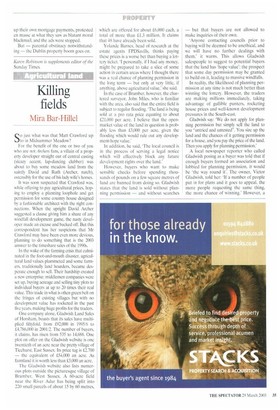Blarney market
Karen Robinson
Arecent news story in the Irish Times began: 'A court has been asked to settle a dispute between a Dublin lesbian couple over the proceeds from their €470,000 [£320,000] former home.' Those not familiar with the changes that have swept through the Irish capital over the last few years would have to wonder which feature of that arresting introduction was the more remarkable: the matter-of-fact reference to a samesex relationship, or the impressive market value of an average house in one of the city's outer suburbs. A house that, even more astonishingly, was worth only £265,000 a year ago, and £175,000 four years ago.
While the English market — particularly in London and the South-east — braces itself for a 'soft landing'. Dublin is flying high, still in the grip of the kind of property fever we are recovering from on this side of the Irish Sea. A seemingly unstoppable stream of new statistics and surveys shows, inter alia, that sales activity here has dropped by a third, more than 80 per cent of respondents have now 'lost interest' in the property market, and, courtesy of the Royal Institution of Chartered Surveyors last week, that the market has just had its biggest fall for eight years.
Not so over there. A browse in an estate agent near St Stephen's Green provokes the reactions that British property window-shoppers have had to become inured to when faced with the provocative combination of distinctly ordinary dwellings, excitable estate-agent blarney and unaffordable price tags. A three-bedroom modern house with nasty stone cladding and no garden in Ballsbridge is described, for no discernible reason other than the €780k price tag, as 'impressive'. A bog-standard chalet bungalow in Dublin 14 is apparently 'substantial' — the price certainly is, at E675k. A 'residence' in Blackrock actually looks rather 'fine' — but so it should be at Q2 million.
And these are just the guide prices: gazumping is alive and well, especially since most of the expensive houses (€600k and above) sell at auction and are, one local property-watcher explained, always pitched too low 'to get a good crowd' and easily go for up to 20 per cent more.
So what is driving this upward surge? 'They say the Celtic tiger is dead, but it's only sleeping,' one leading figure in the Irish property market told me, while another was simply puzzled: 'I don't understand it. Even though the top end of the market seems to have levelled off, seven or eight €1 million-plus houses sold just last week.'
The 'poor mouth' is no longer the thing: conspicuous consumption is in, and ostentatious houses — JR's South Fork has migrated and multiplied in the Dublin suburbs and surrounding countryside — are the proud symbol that you have taken the tiger economy by the tail and emerged the winner.
But a handful of top-euro buyers is as nothing compared to the hordes desperate to get on to the bottom rung of Dublin's property ladder. 'Pent-up demand' is the prospect that has the agents and developers rubbing their hands in glee. Consider the figures: there are, by one estimate, 20,000 wannabe first-time buyers in Dublin. Of the 4,000 new-build homes sold last year. just over half went to first-time buyers, and 30 per cent of second-hand sales also went to property virgins.
At the most recent count, Ireland had about 340 houses for every thousand people, compared with between 400 and 450 for the rest of Europe. As the country's social changes gather force, more divorced dads, young singles and couples — and estranged lesbians — are all anxious for a home of their own in the city. A survey of those who bought new homes in the Dublin area shows that the proportion of single people rose consistently, from 40 per cent in 1997 to 74.5 per cent in 2001. Add to that the estimated 13 per cent of buyers who are returning from abroad, and you begin to understand why whole blocks featuring new starter homes — at about €200k for minimal space, and some with the kind of rudimentary finish that no British developer would get away with these days — are routinely sold out on the day the sales office opens its doors.
But how do they afford it? Interest rates are low — at 3.99 per cent for the average variable-rate mortgage following a 0.25 per cent cut two weeks ago, with another 0.5 per cent fall anticipated over the rest of the year. And half of all first-timers receive financial help from their parents. However, there is a natural limit to parental funds and generosity. One building society caused uproar recently when it ran a television advertising campaign bearing the message that parents should use the equity that the past few years of house-price inflation has given them in their own homes to take out substantial (if cheap) mortgages for their offspring. Middle-aged Irish homeowners, exhausted by a lifetime of keeping
up their own mortgage payments, protested I en masse at what they saw as blatant moral blackmail, and the ads were stopped.
But — parental obstinacy notwithstanding — the Dublin property boom goes on.
Karen Robinson is supplements editor of the Sunday Times.









































































 Previous page
Previous page